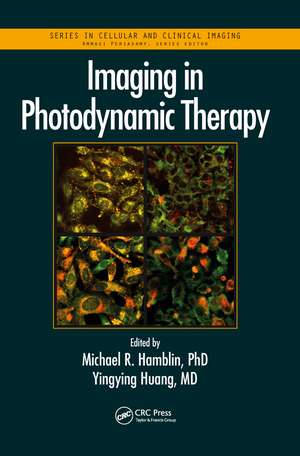Imaging in Photodynamic Therapy: Series in Cellular and Clinical Imaging
Editat de Michael R. Hamblin, Yingying Huangen Limba Engleză Paperback – 31 mar 2021
Preț: 306.25 lei
Preț vechi: 361.66 lei
-15% Nou
Puncte Express: 459
Preț estimativ în valută:
58.60€ • 61.35$ • 48.49£
58.60€ • 61.35$ • 48.49£
Carte tipărită la comandă
Livrare economică 07-21 aprilie
Preluare comenzi: 021 569.72.76
Specificații
ISBN-13: 9780367782351
ISBN-10: 0367782359
Pagini: 501
Dimensiuni: 178 x 254 mm
Greutate: 0.93 kg
Ediția:1
Editura: CRC Press
Colecția CRC Press
Seria Series in Cellular and Clinical Imaging
ISBN-10: 0367782359
Pagini: 501
Dimensiuni: 178 x 254 mm
Greutate: 0.93 kg
Ediția:1
Editura: CRC Press
Colecția CRC Press
Seria Series in Cellular and Clinical Imaging
Cuprins
INTRODUCTION. Looking out the optical window: Physical principles and instrumentation of imaging in photodynamic therapy. Photochemistry and photophysics of PDT and photosensitizers. IN VITRO MICROSCOPY FOR PHOTOSENSITIZER LOCALIZATION IN CELLS. Phthalocyanines in photodynamic therapy. Singlet oxygen luminescence imaging: A prospective tool in bioscience? Microbial biofilms and antimicrobial photodynamic therapy. High-content imaging for photosensitizer screening. IN VITRO MICROSCOPY OF CELL DAMAGE AND DEATH PROCESSES AFTER PDT. Enhanced efficacy of photodynamic therapy via an iron–lysosome–mitochondria connection: Studies with phthalocyanine 4. Role of cell death pathways in response to photodynamic therapy in gliomas. In search of specific PDT photosensitizers: Subcellular localization and cell death pathways. THERANOSTIC AGENTS AND NANOTECHNOLOGY. Quantum dots in PDT. Tetrapyrrole-based theranostic combinations of photodynamic action and magnetic resonance imaging. Theranostic applications of photodynamic molecular beacons. Tumor-specific imaging and photodynamic therapy targeting the urokinase receptor. SMALL ANIMAL IMAGING. Vascular imaging in photodynamic therapy. Photosensitizer activity imaging on the microscopic scale. Bioluminescence imaging for monitoring the effectiveness of photodynamic therapy for infections in animal models. CLINICAL IMAGING. Imaging of photosensitizers in skin. Brain tumor imaging with ALA. PDT of non-muscle-invasive bladder cancer with Hexylester Aminolevulinate: Optimization of the illumination wavelengths by fluorescence spectroscopy and imaging. Endoscopic imaging and photodynamic therapy. Spectroscopic imaging in prostate PDT. Fluorescent-guided resection in clinical oncology.
Notă biografică
Michael R Hamblin Ph.D. is a Principal Investigator at the Wellman Center for Photomedicine at Massachusetts General Hospital, an Associate Professor of Dermatology at Harvard Medical School and is a member of the affiliated faculty of the Harvard-MIT Division of Health Science and Technology. His research interests lie in the areas of photodynamic therapy (PDT) for infections, cancer, and stimulation of the immune system, and in low-level light therapy (LLLT) for wound healing, arthritis, traumatic brain injury, neurodegenerative diseases and psychiatric disorders. He directs a laboratory of around a dozen post-doctoral fellows, visiting scientists and graduate students. His research program is supported by NIH, CDMRP, USAFOSR and CIMIT among other funding agencies. He has published 272 peer-reviewed articles, over 150 conference proceedings, book chapters and International abstracts and holds 8 patents. He is Associate Editor for 7 journals, on the editorial board of a further 12 journals and serves on NIH Study Sections. For the past 10 years Dr Hamblin has chaired an annual conference at SPIE Photonics West entitled "Mechanisms for low level light therapy" and he has edited the 10 proceedings volumes together with four other major textbooks on PDT and photomedicine. He has several other book projects in progress at various stages of completion. In 2011 Dr Hamblin was honored by election as a Fellow of SPIE.
Ying-Ying Huang, M.D., is a scientist in Dr. Michael Hamblin’s lab in Wellman Center for Photomedicine at Massachusetts General Hospital, an Instructor of Dermatology at Harvard Medical School. She was trained as a dermatologist in China. She has been at MGH Wellman Center for 5 years. Her research interests lie in the areas of photodynamic therapy (PDT) for infections, cancer and mechanism of low level light therapy (LLLT) for traumatic brain injury. She has published 48 peer review articles and 15 conference proceedings and book chapters. She is the co-editor of newly released Handbook of Photomedicine
Ying-Ying Huang, M.D., is a scientist in Dr. Michael Hamblin’s lab in Wellman Center for Photomedicine at Massachusetts General Hospital, an Instructor of Dermatology at Harvard Medical School. She was trained as a dermatologist in China. She has been at MGH Wellman Center for 5 years. Her research interests lie in the areas of photodynamic therapy (PDT) for infections, cancer and mechanism of low level light therapy (LLLT) for traumatic brain injury. She has published 48 peer review articles and 15 conference proceedings and book chapters. She is the co-editor of newly released Handbook of Photomedicine
Recenzii
"The editors have skillfully compiled a wide and comprehensive spectrum from contributors around the world on up-to-date imaging technologies for photodynamic therapy (PDT), with a wealth of clinical images."
–Optics & Photonics News
–Optics & Photonics News
Descriere
This book covers the broad field of cellular, molecular, preclinical and clinical imaging associated or combined with photodynamic therapy (PDT). It reflects how the large strides made by PDT in clinical use have resulted in increased studies with imaging elements to optimize treatment. The first sections address basic background, followed by ce






